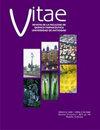Microbiological and physicochemical characterization of a traditionally fermented corn product: "Champús"
Q3 Pharmacology, Toxicology and Pharmaceutics
引用次数: 0
Abstract
Background: Many native fermented foods in Latin America are made by indigenous communities through processes that preserve their traditions. Among these products is champús, a fermented drink or dessert native to Colombia, Ecuador, and Peru. It has a characteristic flavor between sweet and sour with a low alcohol content, is made from cereals such as corn, wheat, or a mixture of these, and can include fruits and spices.Objectives: This research evaluated the microbiological, physicochemical, and sensory quality characteristics of champús to revalue the consumption of traditional foods.Methods: For this purpose, the microbiological safety criteria, fermenting microorganisms, and physicochemical and sensory parameters were evaluated for two batches of champús prepared by five producers and taking samples at different stages. Results: It was found that the average temperature and relative humidity for processing were between 16.5 ± 2.56 °C and 61.6 ± 9.14 %, respectively, and the products exceeded microbiological criteria such as total coliforms and some microbiological criteria forEscherichia coli and Staphylococcus aureus. There was also a high prevalence of lactic acid bacteria and yeasts throughout the process, with the occurrence of the genera Weissella, Leuconostoc, and Lactobacillus. The presence of organic acids (lactic, acetic, and propionic) and ethanol was evidenced. Champús seems to be a source of calcium, phosphorus, and free amino acids. Conclusions: This information provides a basis to propose improvement plans for small producers and, at the same time, to conduct more detailed studies on the native microbiota of champús.一种传统发酵玉米产品的微生物学和物理化学特征:"Champús
背景:拉丁美洲的许多本土发酵食品都是由土著社区通过保留其传统的工艺制作而成的。在这些产品中,有一种原产于哥伦比亚、厄瓜多尔和秘鲁的发酵饮料或甜点 Champús。它的口味酸甜适中,酒精含量低,由玉米、小麦等谷物或谷物混合物制成,还可以加入水果和香料:本研究评估了香普尔的微生物、理化和感官质量特征,以重新评价传统食品的消费价值:为此,对五家生产商制作的两批香普进行了微生物安全标准、发酵微生物、理化和感官参数评估,并在不同阶段采集了样本。结果显示结果发现,加工过程中的平均温度和相对湿度分别为 16.5 ± 2.56 °C 和 61.6 ± 9.14 %,产品中的总大肠菌群等微生物指标以及大肠埃希氏菌和金黄色葡萄球菌等部分微生物指标超标。在整个加工过程中,乳酸菌和酵母菌的流行率也很高,出现了魏氏菌属、白念珠菌属和乳酸杆菌属。有机酸(乳酸、乙酸和丙酸)和乙醇的存在也得到了证实。香普斯似乎是钙、磷和游离氨基酸的来源。结论:这些信息为小生产者提出改进计划提供了依据,同时也为对香普斯本地微生物群进行更详细的研究提供了依据。
本文章由计算机程序翻译,如有差异,请以英文原文为准。
求助全文
约1分钟内获得全文
求助全文
来源期刊

Vitae
PHARMACOLOGY & PHARMACY-
CiteScore
1.20
自引率
0.00%
发文量
0
审稿时长
>12 weeks
期刊介绍:
The journal VITAE is the four-monthly official publication of the School of Pharmaceutical and Food Sciences, and its mission is the diffusion of the scientific and investigative knowledge in the various fields of pharmaceutical and food research, and their related industries. The Journal VITAE is an open-access journal that publishes original and unpublished manuscripts, which are selected by the Editorial Board and then peer-reviewed. The editorial pages express the opinion of the Faculty regarding the various topics of interest. The judgments, opinions, and points of view expressed in the published articles are the responsibility of their authors.
 求助内容:
求助内容: 应助结果提醒方式:
应助结果提醒方式:


